2001 BMW 320i jump start
[x] Cancel search: jump startPage 12 of 211
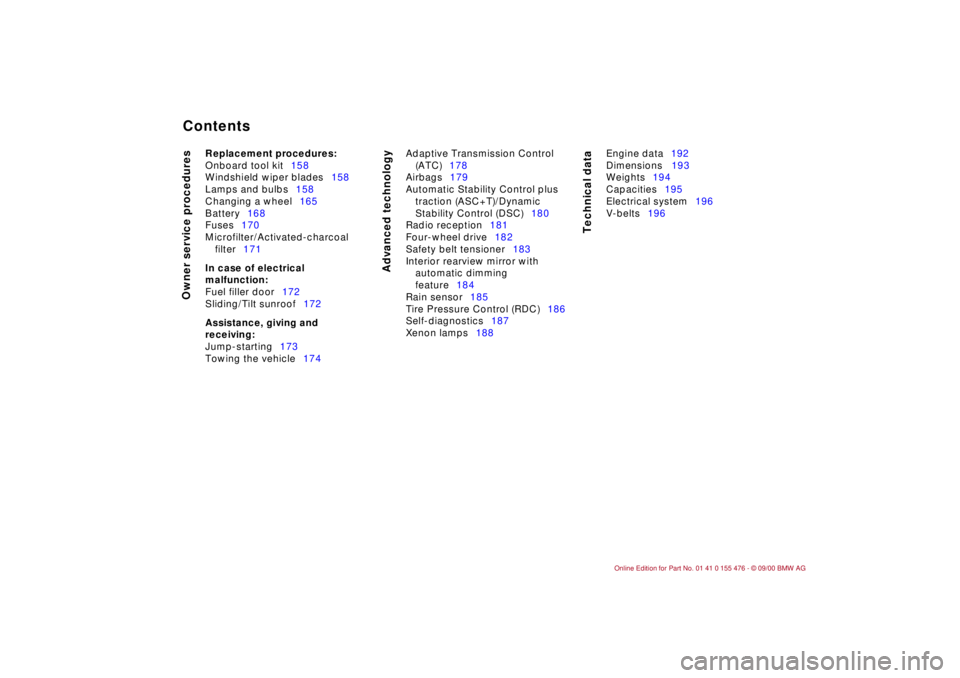
Contents
Owner service procedures
Advanced technology
Technical data
Replacement procedures:
Onboard tool kit158
Windshield wiper blades158
Lamps and bulbs158
Changing a wheel165
Battery168
Fuses170
Microfilter/Activated-charcoal
filter171
In case of electrical
malfunction:
Fuel filler door172
Sliding/Tilt sunroof172
Assistance, giving and
receiving:
Jump-starting173
Towing the vehicle174Adaptive Transmission Control
(ATC)178
Airbags179
Automatic Stability Control plus
traction (ASC+T)/Dynamic
Stability Control (DSC)180
Radio reception181
Four-wheel drive182
Safety belt tensioner183
Interior rearview mirror with
automatic dimming
feature184
Rain sensor185
Tire Pressure Control (RDC)186
Self-diagnostics187
Xenon lamps188Engine data192
Dimensions193
Weights194
Capacities195
Electrical system196
V-belts196
Page 68 of 211
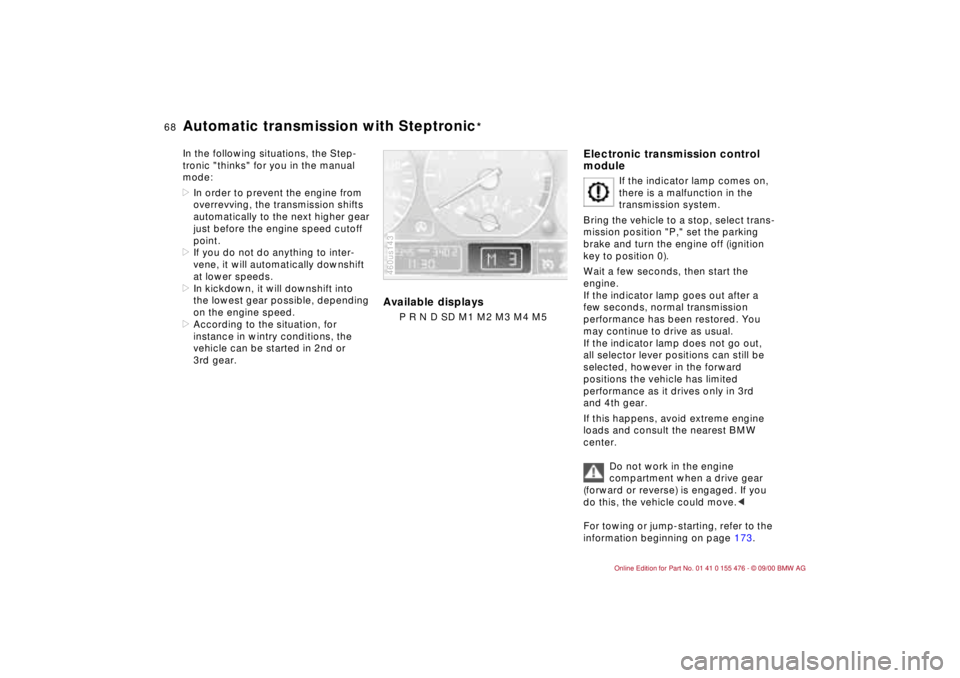
68n
Automatic transmission with Steptronic
*
In the following situations, the Step-
tronic "thinks" for you in the manual
mode:
>In order to prevent the engine from
overrevving, the transmission shifts
automatically to the next higher gear
just before the engine speed cutoff
point.
>If you do not do anything to inter-
vene, it will automatically downshift
at lower speeds.
>In kickdown, it will downshift into
the lowest gear possible, depending
on the engine speed.
>According to the situation, for
instance in wintry conditions, the
vehicle can be started in 2nd or
3rd gear.
Available displays
P R N D SD M1 M2 M3 M4 M5460us143
Electronic transmission control
module
If the indicator lamp comes on,
there is a malfunction in the
transmission system.
Bring the vehicle to a stop, select trans-
mission position "P," set the parking
brake and turn the engine off (ignition
key to position 0).
Wait a few seconds, then start the
engine.
If the indicator lamp goes out after a
few seconds, normal transmission
performance has been restored. You
may continue to drive as usual.
If the indicator lamp does not go out,
all selector lever positions can still be
selected, however in the forward
positions the vehicle has limited
performance as it drives only in 3rd
and 4th gear.
If this happens, avoid extreme engine
loads and consult the nearest BMW
center.
Do not work in the engine
compartment when a drive gear
(forward or reverse) is engaged. If you
do this, the vehicle could move.<
For towing or jump-starting, refer to the
information beginning on page 173.
Page 117 of 211
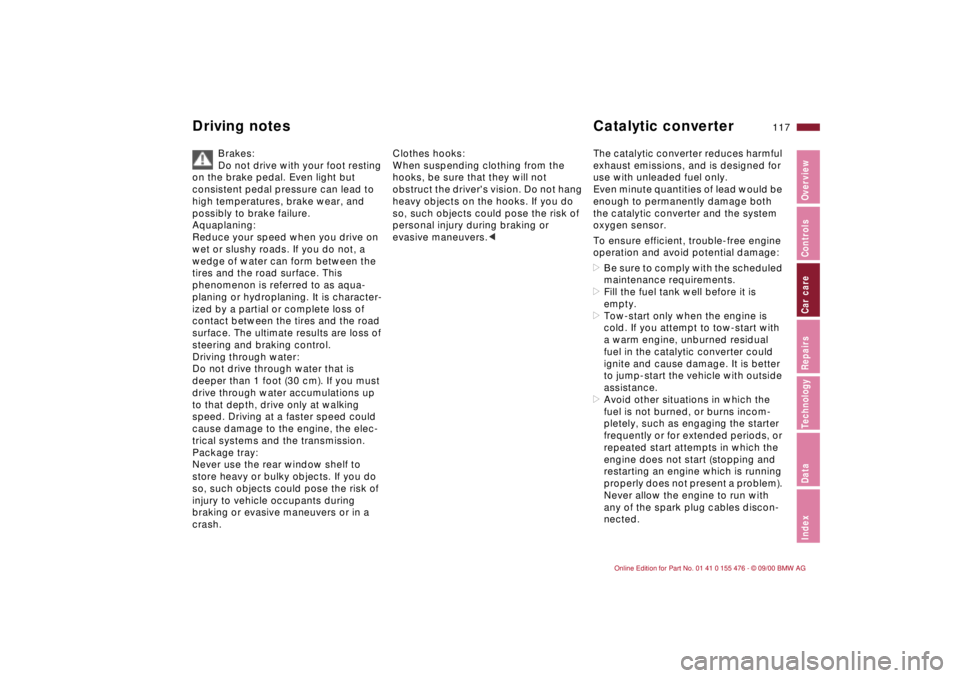
117n
IndexDataTechnologyRepairsCar careControlsOverview
Brakes:
Do not drive with your foot resting
on the brake pedal. Even light but
consistent pedal pressure can lead to
high temperatures, brake wear, and
possibly to brake failure.
Aquaplaning:
Reduce your speed when you drive on
wet or slushy roads. If you do not, a
wedge of water can form between the
tires and the road surface. This
phenomenon is referred to as aqua-
planing or hydroplaning. It is character-
ized by a partial or complete loss of
contact between the tires and the road
surface. The ultimate results are loss of
steering and braking control.
Driving through water:
Do not drive through water that is
deeper than 1 foot (30 cm). If you must
drive through water accumulations up
to that depth, drive only at walking
speed. Driving at a faster speed could
cause damage to the engine, the elec-
trical systems and the transmission.
Package tray:
Never use the rear window shelf to
store heavy or bulky objects. If you do
so, such objects could pose the risk of
injury to vehicle occupants during
braking or evasive maneuvers or in a
crash.
Clothes hooks:
When suspending clothing from the
hooks, be sure that they will not
obstruct the driver's vision. Do not hang
heavy objects on the hooks. If you do
so, such objects could pose the risk of
personal injury during braking or
evasive maneuvers.
use with unleaded fuel only.
Even minute quantities of lead would be
enough to permanently damage both
the catalytic converter and the system
oxygen sensor.
To ensure efficient, trouble-free engine
operation and avoid potential damage:
>Be sure to comply with the scheduled
maintenance requirements.
>Fill the fuel tank well before it is
empty.
>Tow-start only when the engine is
cold. If you attempt to tow-start with
a warm engine, unburned residual
fuel in the catalytic converter could
ignite and cause damage. It is better
to jump-start the vehicle with outside
assistance.
>Avoid other situations in which the
fuel is not burned, or burns incom-
pletely, such as engaging the starter
frequently or for extended periods, or
repeated start attempts in which the
engine does not start (stopping and
restarting an engine which is running
properly does not present a problem).
Never allow the engine to run with
any of the spark plug cables discon-
nected.
Driving notes Catalytic converter
Page 137 of 211
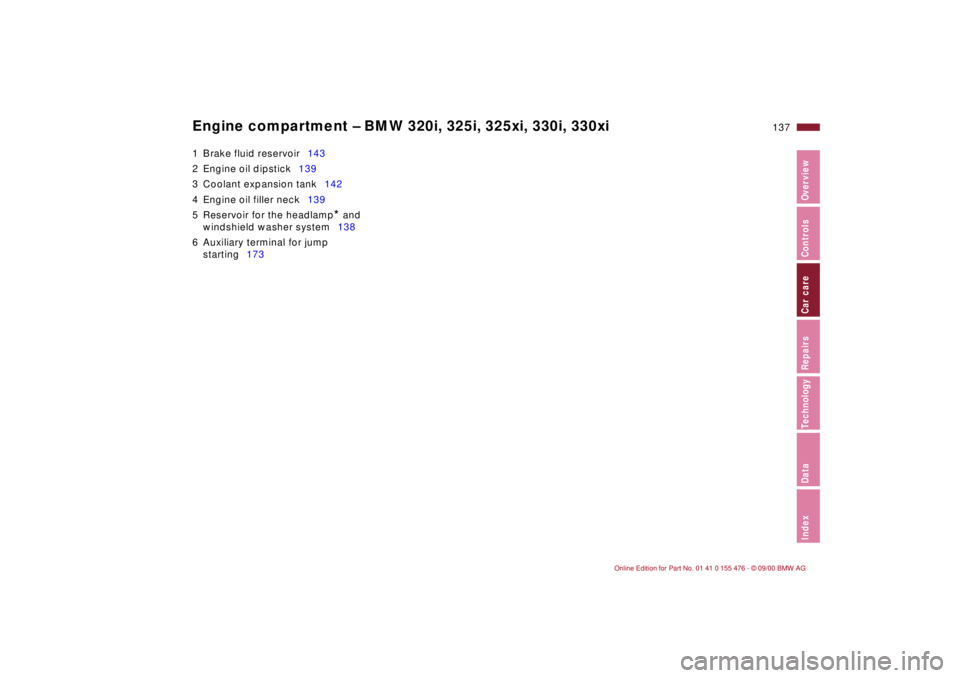
137n
IndexDataTechnologyRepairsCar careControlsOverview
Engine compartment Ð BMW 320i, 325i, 325xi, 330i, 330xi 1 Brake fluid reservoir143
2 Engine oil dipstick139
3 Coolant expansion tank142
4 Engine oil filler neck139
5 Reservoir for the headlamp
* and
windshield washer system138
6 Auxiliary terminal for jump
starting173
Page 157 of 211
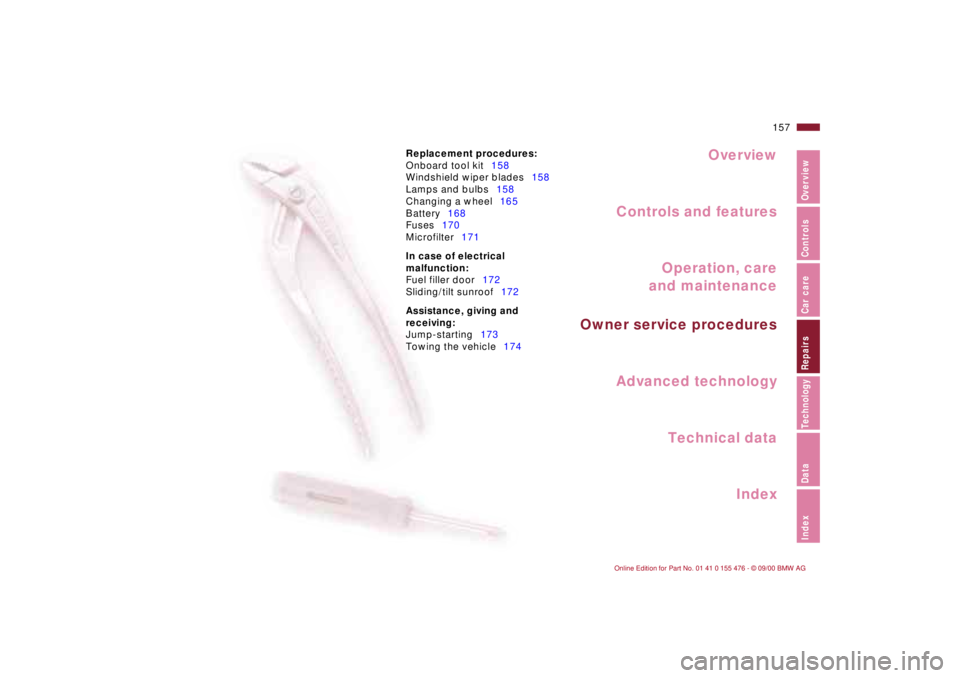
Overview
Controls and features
Operation, care
and maintenance
Owner service procedures
Technical data
Index Advanced technology
157n
IndexDataTechnologyRepairsCar careControlsOverview
Repairs
Replacement procedures:
Onboard tool kit158
Windshield wiper blades158
Lamps and bulbs158
Changing a wheel165
Battery168
Fuses170
Microfilter171
In case of electrical
malfunction:
Fuel filler door172
Sliding/tilt sunroof172
Assistance, giving and
receiving:
Jump-starting173
Towing the vehicle174
Page 173 of 211
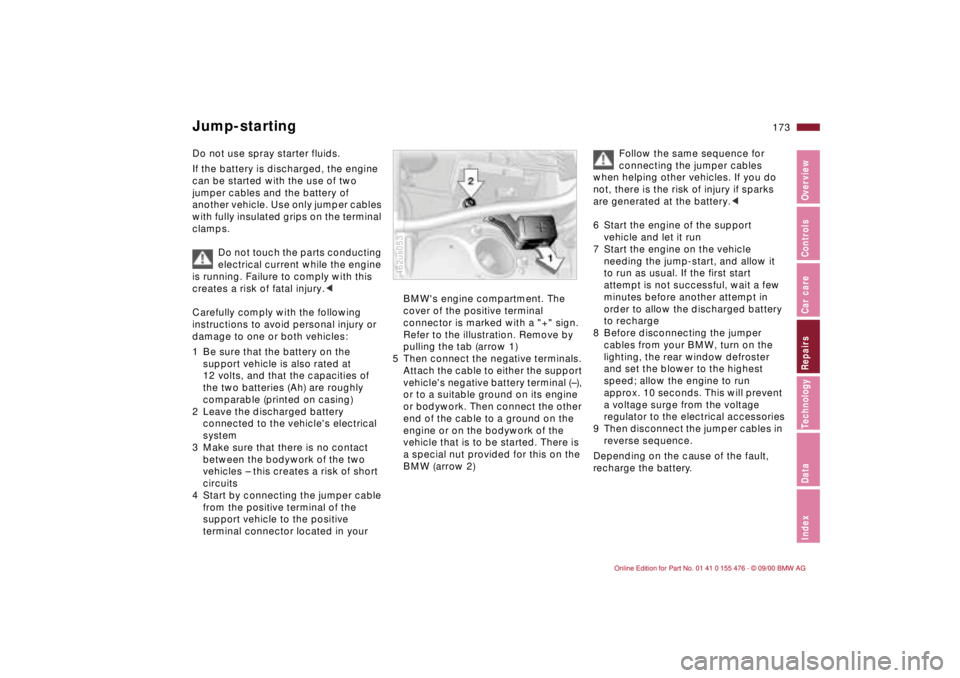
173n
IndexDataTechnologyRepairsCar careControlsOverview
Do not use spray starter fluids.
If the battery is discharged, the engine
can be started with the use of two
jumper cables and the battery of
another vehicle. Use only jumper cables
with fully insulated grips on the terminal
clamps.
Do not touch the parts conducting
electrical current while the engine
is running. Failure to comply with this
creates a risk of fatal injury.<
Carefully comply with the following
instructions to avoid personal injury or
damage to one or both vehicles:
1 Be sure that the battery on the
support vehicle is also rated at
12 volts, and that the capacities of
the two batteries (Ah) are roughly
comparable (printed on casing)
2 Leave the discharged battery
connected to the vehicle's electrical
system
3 Make sure that there is no contact
between the bodywork of the two
vehicles Ð this creates a risk of short
circuits
4 Start by connecting the jumper cable
from the positive terminal of the
support vehicle to the positive
terminal connector located in your
BMW's engine compartment. The
cover of the positive terminal
connector is marked with a "+" sign.
Refer to the illustration. Remove by
pulling the tab (arrow 1)
5 Then connect the negative terminals.
Attach the cable to either the support
vehicle's negative battery terminal (Ð),
or to a suitable ground on its engine
or bodywork. Then connect the other
end of the cable to a ground on the
engine or on the bodywork of the
vehicle that is to be started. There is
a special nut provided for this on the
BMW (arrow 2)462us053
Follow the same sequence for
connecting the jumper cables
when helping other vehicles. If you do
not, there is the risk of injury if sparks
are generated at the battery.<
6 Start the engine of the support
vehicle and let it run
7 Start the engine on the vehicle
needing the jump-start, and allow it
to run as usual. If the first start
attempt is not successful, wait a few
minutes before another attempt in
order to allow the discharged battery
to recharge
8 Before disconnecting the jumper
cables from your BMW, turn on the
lighting, the rear window defroster
and set the blower to the highest
speed; allow the engine to run
approx. 10 seconds. This will prevent
a voltage surge from the voltage
regulator to the electrical accessories
9 Then disconnect the jumper cables in
reverse sequence.
Depending on the cause of the fault,
recharge the battery.
Jump-starting
Page 202 of 211
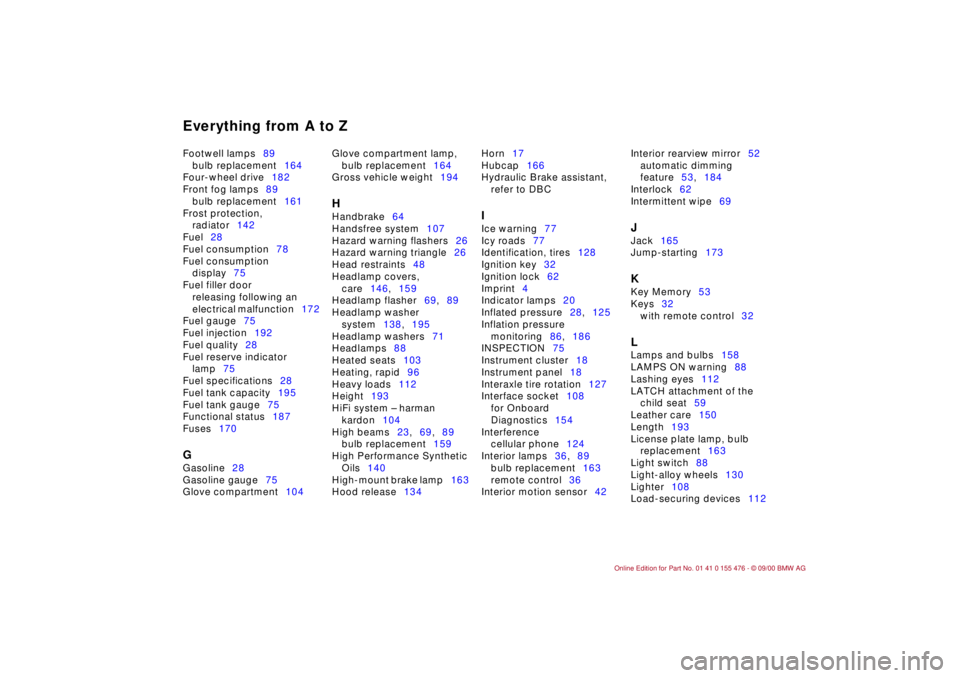
Everything from A to ZFootwell lamps89
bulb replacement164
Four-wheel drive182
Front fog lamps89
bulb replacement161
Frost protection,
radiator142
Fuel28
Fuel consumption78
Fuel consumption
display75
Fuel filler door
releasing following an
electrical malfunction172
Fuel gauge75
Fuel injection192
Fuel quality28
Fuel reserve indicator
lamp75
Fuel specifications28
Fuel tank capacity195
Fuel tank gauge75
Functional status187
Fuses170 G
Gasoline28
Gasoline gauge75
Glove compartment104 Glove compartment lamp,
bulb replacement164
Gross vehicle weight194
H
Handbrake64
Handsfree system107
Hazard warning flashers26
Hazard warning triangle26
Head restraints48
Headlamp covers,
care146,159
Headlamp flasher69,89
Headlamp washer
system138,195
Headlamp washers71
Headlamps88
Heated seats103
Heating, rapid96
Heavy loads112
Height193
HiFi system Ð harman
kardon104
High beams23,69,89
bulb replacement159
High Performance Synthetic
Oils140
High-mount brake lamp163
Hood release134 Horn17
Hubcap166
Hydraulic Brake assistant,
refer to DBC
I
Ice warning77
Icy roads77
Identification, tires128
Ignition key32
Ignition lock62
Imprint4
Indicator lamps20
Inflated pressure28,125
Inflation pressure
monitoring86,186
INSPECTION75
Instrument cluster18
Instrument panel18
Interaxle tire rotation127
Interface socket108
for Onboard
Diagnostics154
Interference
cellular phone124
Interior lamps36,89
bulb replacement163
remote control36
Interior motion sensor42 Interior rearview mirror52
automatic dimming
feature53,184
Interlock62
Intermittent wipe69
J
Jack165
Jump-starting173 K
Key Memory53
Keys32
with remote control32 L
Lamps and bulbs158
LAMPS ON warning88
Lashing eyes112
LATCH attachment of the
child seat59
Leather care150
Length193
License plate lamp, bulb
replacement163
Light switch88
Light-alloy wheels130
Lighter108
Load-securing devices112